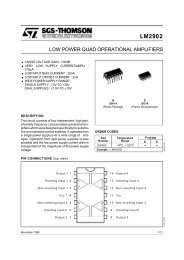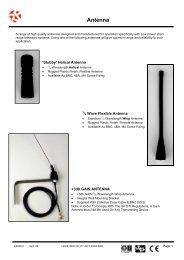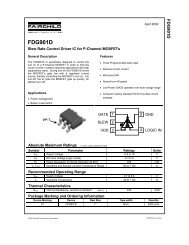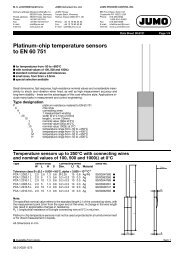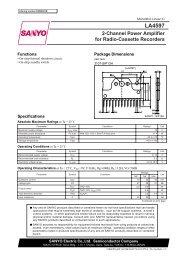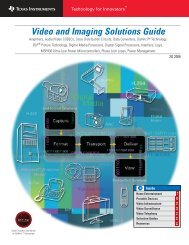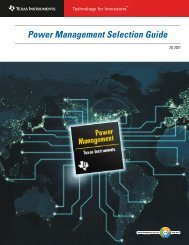Amplifier and Data Converter Selection Guide
Amplifier and Data Converter Selection Guide
Amplifier and Data Converter Selection Guide
- No tags were found...
You also want an ePaper? Increase the reach of your titles
YUMPU automatically turns print PDFs into web optimized ePapers that Google loves.
6 <strong>Amplifier</strong>s<br />
➔<br />
Texas Instruments (TI) offers a wide range of<br />
op amp types including high precision,<br />
microPower, low voltage, high voltage, high<br />
speed <strong>and</strong> rail-to-rail in several different<br />
process technologies. TI has developed the<br />
industry's largest selection of low-power <strong>and</strong><br />
low-voltage op amps with features designed<br />
to satisfy a very wide range of applications.<br />
To help facilitate the selection process, an<br />
interactive online op amp parametric search<br />
engine is available at amplifier.ti.com/search<br />
with links to all op amp specifications.<br />
Design Considerations<br />
Choosing the best op amp for an application<br />
involves consideration of a variety of interrelated<br />
requirements. In doing so, designers<br />
must often consider conflicting size, cost <strong>and</strong><br />
performance objectives. Even experienced<br />
engineers can find the task daunting, but it<br />
need not be so. Keeping in mind the following<br />
issues, the choices can quickly be narrowed<br />
to a manageable few.<br />
Supply voltage (V S )—tables include low<br />
voltage (< 2.7V min) <strong>and</strong> wide voltage range<br />
(> 5V min) sections. Other op amp selection<br />
criteria (e.g., precision) can be quickly examined<br />
in the supply range column for an<br />
appropriate choice. Applications operating<br />
from a single power supply may require<br />
rail-to-rail performance <strong>and</strong> consideration<br />
of precision-related parameters.<br />
Precision—primarily associated with input<br />
offset voltage (V OS ) <strong>and</strong> its change with<br />
respect to temperature drift, PSRR <strong>and</strong><br />
CMRR. It is generally used to describe op<br />
amps with low input offset voltage <strong>and</strong> low<br />
input offset voltage temperature drift.<br />
Precision op amps are required when<br />
amplifying tiny signals from thermocouples<br />
<strong>and</strong> other low-level sensors. High-gain or<br />
multi-stage circuits may require low<br />
offset voltage.<br />
Gain b<strong>and</strong>width product (GBW)—the gain<br />
b<strong>and</strong>width of a voltage-feedback op amp<br />
determines its useful b<strong>and</strong>width in an<br />
application. The maximum available b<strong>and</strong>width<br />
is approximately equal to the gain b<strong>and</strong>width<br />
divided by the closed-loop gain of the application.<br />
For voltage feedback amplifiers, GBW is<br />
a constant. Many applications benefit from<br />
choosing a much wider b<strong>and</strong>width/slew rate<br />
op amp to achieve low distortion, excellent<br />
linearity, good gain accuracy, gain flatness<br />
or other behavior that is influenced by<br />
feedback factors.<br />
Power (I Q requirements)—a significant issue<br />
in many applications. Because op amps can<br />
have a considerable impact on the overall<br />
system power budget, quiescent current,<br />
especially in battery-powered applications,<br />
is a key design consideration.<br />
Rail-to-rail performance—rail-to-rail<br />
output provides maximum output voltage<br />
swing for widest dynamic range. This may be<br />
particularly important with low operating<br />
voltage where signal swings are limited.<br />
Rail-to-rail input capability is often required<br />
to achieve maximum signal swing in buffer<br />
(G = 1) single-supply applications. It can be<br />
useful in other applications, depending on<br />
amplifier gain <strong>and</strong> biasing considerations.<br />
Voltage noise (V N )—amplifier-generated<br />
noise may limit the ultimate dynamic range,<br />
accuracy or resolution of a system. Lownoise<br />
op amps can improve accuracy, even in<br />
slow DC measurements.<br />
Input bias current (I B )—can create offset<br />
error by reacting with source or feedback<br />
impedance. Applications with high source<br />
impedance or high impedance feedback<br />
elements (such as transimpedance amplifiers<br />
or integrators) often require low input bias<br />
Common Op Amp Design Questions<br />
What is the amplitude of the<br />
input signal<br />
To ensure signal errors are small relative to<br />
the input signal, small input signals require<br />
high precision (e.g., low offset voltage)<br />
amplifiers. Ensure that the amplified output<br />
signal stays within the amplifier<br />
output voltage.<br />
Will the ambient temperature vary<br />
Op amps are sensitive to temperature<br />
variations, so it is important to consider<br />
offset voltage drift over temperature.<br />
Does the common-mode voltage vary<br />
Make sure the op amp is operated<br />
within its common-mode range <strong>and</strong> has an<br />
adequate common-mode rejection ratio<br />
current. FET-Input <strong>and</strong> CMOS op amps<br />
generally provide very low input bias current.<br />
Slew rate—the maximum rate of change of<br />
the amplifier output. It is important when<br />
driving large signals to high frequency. The<br />
available large signal b<strong>and</strong>width of an op<br />
amp is determined by the slew rate<br />
(f = SR/2πA).<br />
Package size—TI offers a wide variety of<br />
microPackages, including WCSP, SOT23,<br />
SC70 <strong>and</strong> small, high power-dissipating<br />
PowerPAD packages to meet spacesensitive<br />
<strong>and</strong> high-output drive requirements.<br />
Many TI single-channel op amps are<br />
available in SOT23, with some dual<br />
amplifiers in SOT23-8.<br />
Shutdown mode—an enable/disable<br />
function that places the amp in a high<br />
impedance state, reducing quiescent current<br />
in many cases to less than 1µA. Allows<br />
designers to use wide b<strong>and</strong>width op amps in<br />
lower power applications, enabling them<br />
only when they are needed.<br />
Decompensated amplifiers—for<br />
applications with gain greater than unity<br />
gain (G > 1), decompensated amps<br />
provide significantly higher b<strong>and</strong>width,<br />
improved slew rate <strong>and</strong> lower distortion over<br />
their unity-gain stable counterparts on the<br />
same quiescent current or noise.<br />
(CMRR). Common-mode voltage will induce<br />
additional offset voltage.<br />
Does the power supply voltage vary<br />
Power supply variations affect the<br />
offset voltage. This may be especially<br />
important in battery-powered applications.<br />
Precision Application Examples<br />
• High gain circuits (G > 100)<br />
• Measuring small input signals<br />
(e.g., from a thermocouple)<br />
• Wide operating temperature range<br />
circuits (i.e., in automotive or<br />
industrial applications)<br />
• Single-supply ≤ 5V data-acquisition<br />
systems where input voltage span<br />
is limited<br />
<strong>Amplifier</strong> <strong>and</strong> <strong>Data</strong> <strong>Converter</strong> <strong>Selection</strong> <strong>Guide</strong> Texas Instruments 3Q 2006



